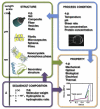A review of combined experimental and computational procedures for assessing biopolymer structure-process-property relationships
- PMID: 22938765
- PMCID: PMC3787124
- DOI: 10.1016/j.biomaterials.2012.06.054
A review of combined experimental and computational procedures for assessing biopolymer structure-process-property relationships
Abstract
Tailored biomaterials with tunable functional properties are desirable for many applications ranging from drug delivery to regenerative medicine. To improve the predictability of biopolymer materials functionality, multiple design parameters need to be considered, along with appropriate models. In this article we review the state of the art of synthesis and processing related to the design of biopolymers, with an emphasis on the integration of bottom-up computational modeling in the design process. We consider three prominent examples of well-studied biopolymer materials - elastin, silk, and collagen - and assess their hierarchical structure, intriguing functional properties and categorize existing approaches to study these materials. We find that an integrated design approach in which both experiments and computational modeling are used has rarely been applied for these materials due to difficulties in relating insights gained on different length- and time-scales. In this context, multiscale engineering offers a powerful means to accelerate the biomaterials design process for the development of tailored materials that suit the needs posed by the various applications. The combined use of experimental and computational tools has a very broad applicability not only in the field of biopolymers, but can be exploited to tailor the properties of other polymers and composite materials in general.
Copyright © 2012 Elsevier Ltd. All rights reserved.
Figures



Similar articles
-
Synergistic Integration of Experimental and Simulation Approaches for the de Novo Design of Silk-Based Materials.Acc Chem Res. 2017 Apr 18;50(4):866-876. doi: 10.1021/acs.accounts.6b00616. Epub 2017 Feb 13. Acc Chem Res. 2017. PMID: 28191922 Free PMC article. Review.
-
Silk-elastin-like protein biomaterials for the controlled delivery of therapeutics.Expert Opin Drug Deliv. 2015 May;12(5):779-91. doi: 10.1517/17425247.2015.989830. Epub 2014 Dec 5. Expert Opin Drug Deliv. 2015. PMID: 25476201 Free PMC article. Review.
-
Drug Release from Porous Matrixes based on Natural Polymers.Curr Pharm Biotechnol. 2017;18(9):721-729. doi: 10.2174/1389201018666171103141347. Curr Pharm Biotechnol. 2017. PMID: 29110601 Review.
-
Recent Advances in Biopolymeric Composite Materials for Tissue Engineering and Regenerative Medicines: A Review.Molecules. 2021 Jan 25;26(3):619. doi: 10.3390/molecules26030619. Molecules. 2021. PMID: 33504080 Free PMC article. Review.
-
Recombinant protein blends: silk beyond natural design.Curr Opin Biotechnol. 2016 Jun;39:1-7. doi: 10.1016/j.copbio.2015.11.002. Epub 2015 Dec 10. Curr Opin Biotechnol. 2016. PMID: 26686863 Review.
Cited by
-
Self-assembly in elastin-like recombinamers: a mechanism to mimic natural complexity.Mater Today Bio. 2019 May 20;2:100007. doi: 10.1016/j.mtbio.2019.100007. eCollection 2019 Mar. Mater Today Bio. 2019. PMID: 32159144 Free PMC article. Review.
-
Spider silk gut: development and characterization of a novel strong spider silk fiber.Sci Rep. 2014 Dec 5;4:7326. doi: 10.1038/srep07326. Sci Rep. 2014. PMID: 25475975 Free PMC article.
-
Bioarchitectural Design of Bioactive Biopolymers: Structure-Function Paradigm for Diabetic Wound Healing.Biomimetics (Basel). 2024 May 4;9(5):275. doi: 10.3390/biomimetics9050275. Biomimetics (Basel). 2024. PMID: 38786486 Free PMC article. Review.
-
In Vivo Osteogenic Differentiation of Human Embryoid Bodies in an Injectable in Situ-Forming Hydrogel.Materials (Basel). 2013 Jul 17;6(7):2978-2988. doi: 10.3390/ma6072978. Materials (Basel). 2013. PMID: 28811417 Free PMC article.
-
Glycerin-Induced Conformational Changes in Bombyx mori Silk Fibroin Film Monitored by (13)C CP/MAS NMR and ¹H DQMAS NMR.Int J Mol Sci. 2016 Sep 9;17(9):1517. doi: 10.3390/ijms17091517. Int J Mol Sci. 2016. PMID: 27618034 Free PMC article.
References
-
- Burg KJL, Porter S, Kellam JF. Biomaterial developments for bone tissue engineering. Biomaterials. 2000;21:2347–59. - PubMed
-
- Jeong B, Bae YH, Lee DS, Kim SW. Biodegradable block copolymers as injectable drug-delivery systems. Nature. 1997;388:860–2. - PubMed
-
- Qiu Y, Park K. Environment-sensitive hydrogels for drug delivery. Adv Drug Deliv Rev. 2001;53:321–39. - PubMed
-
- Griffith LG. Emerging design principles in biomaterials and scaffolds for tissue engineering. Ann N Y Acad Sci. 2002;961:83–95. - PubMed
-
- U.S. National Science and Technology Council . Materials genome initiative for global competitiveness. Executive Office of the President; Washington: 2011.
Publication types
MeSH terms
Substances
Grants and funding
LinkOut - more resources
Full Text Sources

